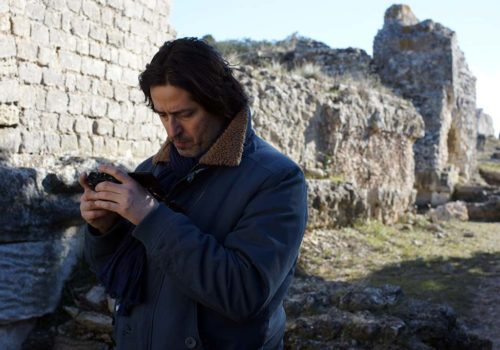Marco Zappone directed the book Champs de bataille (Battlefields). This 660 page book gathers together 430 photographs and was produced by Éditions Photosynthèses, one of the publishing houses of Vera Michalski. It is thanks to them that this book has been possible.
Interview with Yan Morvan
Marco Zappone: Over the years you have photographed war, publishing numerous images of devastation and violence, noise and fury. You captured war in action, beneath the deafening noise of the shooting and the bombs that rained down.
Yan Morvan: Champs de bataille, it’s quieter…
MZ.: The title evokes war but ancient wars, that happened but is no longer exist in the places you photograph today. For a few years now you’ve devoted yourself to a real photographic campaign, from continent to continent, travelling from one era to another, from one war to another, wars of another time. Why photograph these places that have witnessed war but where there is no longer war?
YM.: In all these places, fixed in time with a view camera, we continue to show the vanity of mankind, the desire for power, for strength and, everywhere from Carthage to Austerlitz, or even Verdun, the accumulation of ruins show the work of mankind regained by the silence of nature. In Champs de bataille, it shows that after the wars, with the passage of time, there remains just one thing, nature in its abundance, its beauty, its strength, and the people who pass through it.
MZ.: You evoke the silence and the tranquillity of nature after the battle. I recall the spirit of the last words of the prince of Denmark, “The rest is silence”. What remains is the silence, yet from which emanates, with the accumulation of these places of death, a muffled violence. How much has your career as a top-level war photographer influenced your shots? Are the two paths different?
YM.: Why photograph war, and the places where it has raged? It can be that these questions are one and the same, to which the reply, identically, was the continuing thread of my existence and comes close to this other question often posed to war reporters, “Do you think you have any influence over the events?”. I believe that we all think about this, less in our youth and more, fortunately, at that moment when you can imagine that the world is going to change, that you yourself can be an actor in that change. You are full of ideas and projects to struggle against fate. And sometimes life proves us right. Photographs change points of view, laws. They do move boundaries. In 1978, following the production of a campaign to improve road safety, in this way one of my photographs created a shock wave far beyond my awareness at the moment when I took the shot. A CRS officer had shot a dog abandoned on the highway. Paris Match, the great magazine of that era, published it, provoking such a wave of indignation that it led the government and the president Valéry Giscard d’Estaing to have a vote on a law against the shooting of dogs. So yes, the world can be changed by photos, Certainly not totally, the opportunity to change things exists. In the case of war photographs the awareness that you have of your desire to make society evolve, is greater. For example in Beirut, 1st August 1982, the city was shelled by the Israelis. If at that precise moment you took photos that proved this shelling, certainly you would expect, and you would wish fervently, that this captured instant could bring about a cease-fire. In concrete terms, there would be 100 or 200 people who would not have been killed. And it is that, every day, the war photograph, is concrete. That is “to inform”. But today, the rules of the game have changed. It is continuous news, it’s necessary to feed the communication machine continuously so that it can receive its daily dose of news. The news consumes itself like a drug. These days, events follow one another and die in twenty-four or forty-eight hours, whereas in the 1970s, an event lasted. A story stretched out for a week, a month or two. At this time, even the most important event has a life of three or four days, not more. The speed of the social networks plunges us into the heart of the action, so you could have been an observer during the recent attacks. So it’s necessary to feed continuously this kind of machine that produces the news, kneads it, directs it and in the end finish by crushing it.
The full article is available in french version of L’Oeil de la Photographie.
BOOK
Champs de bataille
Yan Morvan
Editions Photosynthèses (Release on Novemberth, 2015)
660 pages
32,5 x 5,9 x 26,7 cm
http://editionsphotosyntheses.fr
EXHIBITION
Champs de bataille [Battlefields]
Yan Morvan
In Part of Photo Saint Germain
From 6 to 22 November 2015
Galerie Rue de L’Abbaye
13, Rue de L’Abbaye
75006 Paris
France
















